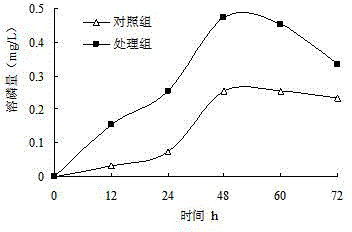Efficient phosphate-dissolving bacterium and produced bacterial agent thereof
A technology of phosphorus-solubilizing bacteria and bacterial agents, applied in the direction of bacteria, microorganism-based methods, microorganisms, etc., can solve the problems of low phosphorus conversion rate, low utilization rate of chemical phosphate fertilizer, and easy pollution of the environment, so as to improve soil environment and fertility, The effect of increasing crop yield and reducing environmental pollution
- Summary
- Abstract
- Description
- Claims
- Application Information
AI Technical Summary
Problems solved by technology
Method used
Image
Examples
Embodiment 1
[0017] Embodiment 1: the production of phosphate solubilizing bacteria agent
[0018] (1) Shake flask culture
[0019] Activate phosphate-solubilizing bacteria 21-III on a beef extract peptone culture dish, streak and pick a single colony for two cultures, then pick a single colony and inoculate it on the slant medium of the test tube for later use; the strain on the slant medium of the test tube , inoculated in a triangular flask containing beef extract peptone medium, and cultured in a shake flask until the logarithmic growth phase. The culture conditions were 26-32 ℃, rotation speed 140-200 rpm, liquid volume in 500 mL Erlenmeyer flask was 150-300 mL, and culture time was 24-36 h. The composition of beef extract-peptone medium is beef extract 3 g / L, peptone 10 g / L, NaCl 5 g / L, pH 7.0-7.2.
[0020] (2) Fermentation tank culture
[0021] Inoculate the above-mentioned shake flask bacterial liquid in the fermentation medium of phosphate-solubilizing bacteria agent, the inocu...
Embodiment 2
[0022] Embodiment 2: laboratory calcium phosphate dissolution experiment
[0023] After the activation of strain 21-III on the beef extract peptone medium plate, inorganic calcium phosphate was used as an insoluble phosphorus source to prepare inorganic phosphorus medium and inoculate 21-III with an inoculation ratio of 5%. At the same time, a parallel system without bacteria was set up as a control. In order to eliminate the interference of the system itself. The culture solution was regularly and quantitatively sampled, filtered through a 0.22 μm microporous membrane, and the molybdenum antimony anti-spectrophotometric method was used to measure the content of soluble phosphate. After excluding the control value, the results were shown in figure 1 As shown, it shows that at 72 h, the amount of phosphorus dissolved is the largest, reaching 16.6 μmol / mL (calculated as PO4), which can effectively dissolve insoluble particulate calcium phosphate.
[0024] In this embodiment 2,...
Embodiment 3
[0025] Example 3: Soil Phosphorus Solubilization Efficiency
[0026] The test soil was collected from farmland in the suburbs of Zhengzhou City, and the sampling depth was 0-20 cm. Remove impurities after collection. Add 90 mL of sterile water to 30 g of soil. Inoculate 10 mL of 21-III bacterial agent as the treatment group; at the same time, inoculate 10 mL of inactivated 21-III bacterial agent as the parallel control group. Under normal temperature conditions, let it stand still, take the supernatant at a predetermined time point, and measure the soluble available phosphorus content therein. see results figure 2 shown. The results showed that the dissolution of soil phosphorus by the bacterial agent reached the highest at 48 h, and compared with the control group, the content of soluble phosphorus in the soil increased by 1.87 times under the action of the bacterial agent.
PUM
 Login to View More
Login to View More Abstract
Description
Claims
Application Information
 Login to View More
Login to View More - R&D
- Intellectual Property
- Life Sciences
- Materials
- Tech Scout
- Unparalleled Data Quality
- Higher Quality Content
- 60% Fewer Hallucinations
Browse by: Latest US Patents, China's latest patents, Technical Efficacy Thesaurus, Application Domain, Technology Topic, Popular Technical Reports.
© 2025 PatSnap. All rights reserved.Legal|Privacy policy|Modern Slavery Act Transparency Statement|Sitemap|About US| Contact US: help@patsnap.com


